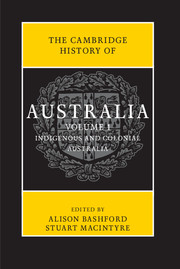Book contents
- Frontmatter
- Contents
- Abbreviations
- List of maps
- List of figures
- List of tables
- Notes on contributors
- Map
- Preface
- Introduction
- PART I
- PART II
- Further reading
- Chronology
- Index
- Frontmatter
- Contents
- Abbreviations
- List of maps
- List of figures
- List of tables
- Notes on contributors
- Map
- Preface
- Introduction
- PART I
- PART II
- 9 Religion
- 10 Culture and media
- 11 Science and medicine
- 12 Society and welfare
- 13 Gender and sexuality
- 14 Indigenous Australia
- 15 Class
- 16 The economy
- 17 Government, law and citizenship
- 18 Education
- 19 The environment
- 20 Travel and connections
- 21 Security
- 22 Australia, Britain and the British Commonwealth
- 23 Australia in the Asia-Pacfic region
- 24 The history anxiety
- Further reading
- Chronology
- Index
13 - Gender and sexuality
from PART II
Published online by Cambridge University Press: 05 November 2013
- Frontmatter
- Contents
- Abbreviations
- List of maps
- List of figures
- List of tables
- Notes on contributors
- Map
- Preface
- Introduction
- PART I
- PART II
- Further reading
- Chronology
- Index
- Frontmatter
- Contents
- Abbreviations
- List of maps
- List of figures
- List of tables
- Notes on contributors
- Map
- Preface
- Introduction
- PART I
- PART II
- 9 Religion
- 10 Culture and media
- 11 Science and medicine
- 12 Society and welfare
- 13 Gender and sexuality
- 14 Indigenous Australia
- 15 Class
- 16 The economy
- 17 Government, law and citizenship
- 18 Education
- 19 The environment
- 20 Travel and connections
- 21 Security
- 22 Australia, Britain and the British Commonwealth
- 23 Australia in the Asia-Pacfic region
- 24 The history anxiety
- Further reading
- Chronology
- Index
Summary
The population of colonial Australia was always marked by a significant imbalance in the ratio of European men and women, which closed only at the beginning of the twentieth century. Its legacy was a highly masculinist culture, where violence against women, especially Indigenous women, was common and women were treated as bedmates, child bearers and domestic workers. Feminists of the late nineteenth and early twentieth centuries campaigned vociferously for women's bodily autonomy, recognition of their importance as mothers, and the right to vote and participate in government. The suffrage campaigns were rewarded by the relatively early extension of the franchise at State levels between 1894 (South Australia) and 1909 (Victoria). The right to vote for and stand for election in the Commonwealth parliament was granted to white women who were British subjects in 1902. Feminists argued for the women's vote on the grounds of equality with men, but also because of the maternal values women would bring to public life. It was an argument that spoke directly to the racialised concerns of a new nation in need of white mothers to populate its vast expanses. This anxiety about population, its growth and colour, would continue to shape attitudes towards gender and sexuality across the century and beyond.
Citizen-workers and citizen-mothers
Marriage and family was the expected life course for both men and women. Heterosexuality was normalised and sexual self-control was the ideal for all, though in practice women were held to this more tightly than men. While sex was often understood as an essential or inevitable part of men's lives, the strong emphasis on motherhood and racial fitness left little room for non-procreative notions of female sexuality. In the period after Federation there was an emphasis on sexual and social purity that belied a deep interest in, and discussion of, sex. There were significant public conversations about the age of consent, prostitution, rape and masturbation. As one commentator remarked in 1917: ‘you can't move without Sex being flung in your face’.
- Type
- Chapter
- Information
- The Cambridge History of Australia , pp. 308 - 331Publisher: Cambridge University PressPrint publication year: 2013
- 2
- Cited by



